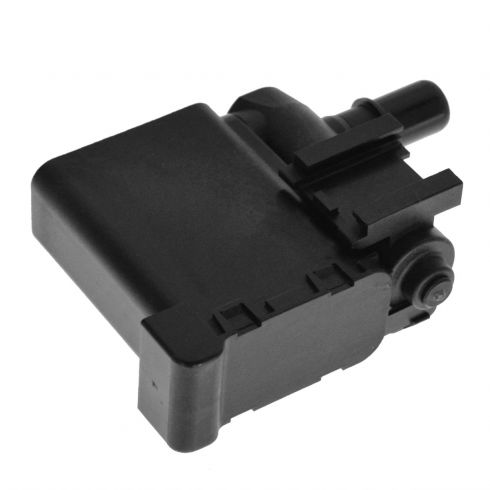This keeps air pollution down, and keeps the smell of fuel from reaching the inside of your vehicle. How Evap orative Emission Control System s Work. A typical system consists of a small canister full of charcoal, valves, hoses, vents in the fuel lines and a sealed fuel tank cap. When fuel evaporates inside the gas tank, the excess vapors are transferred to the charcoal canister.
When your engine light comes on because of a weakness or failure in this system , you most likely won’t notice the car driving any differently. Everything will seem fine, except for the glowing check engine light on the dashboard. The canister purge valve allows stored fuel vapors in the containment canister to be recycled back into the engine combustion process when necessary. If there is a leak, usually caused by a loose or badly damaged gas cap, it triggers an event which activates the Check Engine light in the instrument panel.
The labor alone will cost somewhere between $and $14 while parts will run somewhere between $1and $440. The internal combustion process creates noxious chemicals (like COand nitrogen oxides) that are released into the air as we drive. The system can test the evap orative.
The powertrain control module (PCM) then monitors the ability of the system to maintain the vacuum. The computer in the car tells the system when to purge the charcoal canisters containing the gasoline vapors. Whenever there is any gas in the tank, your vehicle is emitting vapors. EVAP canister purge valve.
Typically, these are consistent and aren’t harmful to the engine or driving. This is important because fuel vapors contain a variety of hydrocarbons. AnswerAn Evap leak in a car is usually fuel fumes leaking from the evap system. The purpose of the system is to expel pressure built in the gas tank,. Unfortunately, not many car owners understand or realize this.
In this article a GM truck is used. Nine times out of ten when this code is set the system has a problem it is because of a leak somewhere between the intake manifold and the vacuum control solenoid. This could be a loose or faulty vacuum feed line because of a worn O ring seal or a hose that has falling off or has a tear. That is the main reason when refuelling you. The evaporative emissions system is complex, but the functioning is straight forward.
At the top of the fuel tank is a roll-over valve.
This valve closes in case of a roll-over and helps prevent fuel loss. Nothing bad will happen to your car. You can postpone repairs as long as you wish, until inspection time rolls around. I found this somewhere on the web.
Sounds like evap canister needs to be purged. This system will return the vapor to the overall combustion process, designed to prevent the dangerous chemicals reaching for air,. My Haynes manual says the leak detection pump should come on during cold starts.
I checked for power at the plug for the LDP during cold start and I am getting power there.

If the light comes back after Seafoam treatment - purge evap canister and check purge valve. Lastly, I remember evap canister is a large black canister located between the engine and firewall. Gasoline fumes leave the tank through the roll-over valve. Answer An Evap leak in a car is usually fuel fumes leaking from the evap system.
Fuel vapors are routed by hoses to a charcoal canister for storage. Later, when the engine is running a purge control valve opens allowing intake vacuum to siphon the fuel vapors into the engine to be burned. Fill Your Cart With Color today! The fuel vapors are actually absorbed by the charcoal canister. It regulates the engine and fuel tank vapors.
The specific fault code stored will help to determine what the problem is. As the engine runs, vapors are drawn into the cylinders and are burned. The performance problem and odor of gasoline arise if the canister cracks,.
Canister purge valves are also used in “leak tests,” by allowing a vacuum. Any smoke leaking from the system will illuminate in the ultraviolet light. The Engine Control Module (ECM) controls the flow rate of the vapors dispose to the intake manifold. When the car is started the trapped vapors are introduced into the combustion chamber (through the open purge valve) for burning. This is also the primary gauge I use to test different evap systems.
Hg gauge (attached to the pump) is not used at all. Any where there is smoke exiting the system , that is the faulty component. Evaporative emissions control. If the system is sealing properly, the number will stay consistent.
If is isn’t, the pressure sensor will show that as well. Common Symptoms of a Bad Evap Canister. When the vehicle is in action, the temperature will rise and its fuel will evaporate then become vapor.
Evap system and catalytic converter did not have a reading on the smog machine. Drove car around in a week. Had smog machine connected again. After a period of driving, 5-minutes, the ECM cycles the purge VSV.
Next, the ECM will close the CCV and open the bypass VSV while continuing to operate the purge VSV. Making your own smoke evap tester. In a typical passenger car or pickup truck, the evaporator is usually located inside the passenger compartment, quite often deeply buried in or under the instrument panel. One lose gas cap or you are fill ing it up while your car is running. Two the natNatural Vacuum Leak Detection (NVLD) assembly, which is located on top of the charcoal canister, which is mounted above the fuel tank leaking.
The evap system does a pressuer check on cold start ups.
No comments:
Post a Comment
Note: only a member of this blog may post a comment.